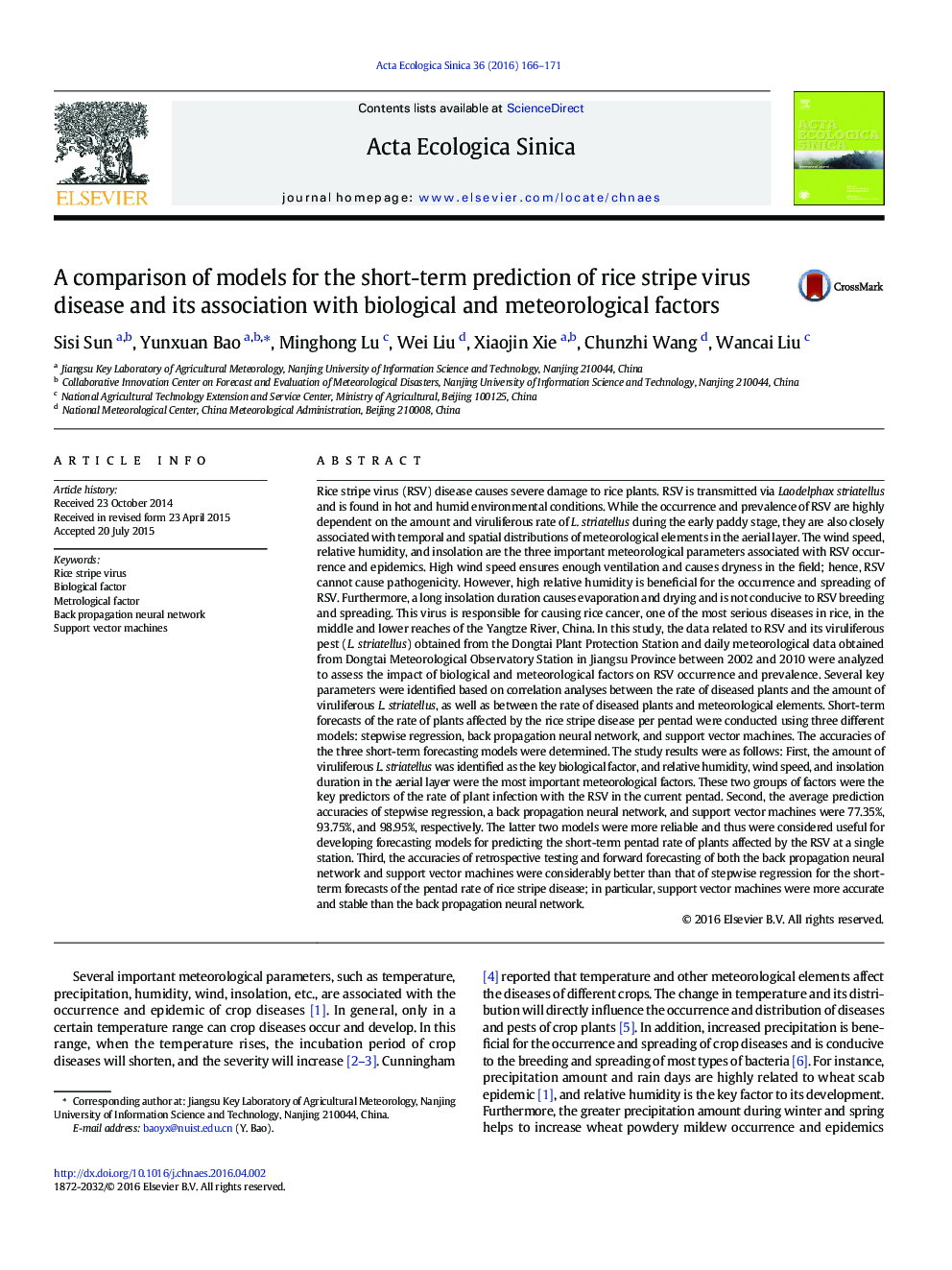| کد مقاله | کد نشریه | سال انتشار | مقاله انگلیسی | نسخه تمام متن |
|---|---|---|---|---|
| 4379784 | 1303937 | 2016 | 6 صفحه PDF | دانلود رایگان |
عنوان انگلیسی مقاله ISI
A comparison of models for the short-term prediction of rice stripe virus disease and its association with biological and meteorological factors
ترجمه فارسی عنوان
مقایسه مدل های پیش بینی کوتاه مدت بیماری ویروس نوار برنج و ارتباط آن با عوامل بیولوژیک و هواشناسی
دانلود مقاله + سفارش ترجمه
دانلود مقاله ISI انگلیسی
رایگان برای ایرانیان
کلمات کلیدی
ویروس نوار برنج، عامل زیستی، فاکتور متالوگرافی، شبکه عصبی پخش برگشتی، ماشین آلات بردار پشتیبانی،
موضوعات مرتبط
علوم زیستی و بیوفناوری
علوم کشاورزی و بیولوژیک
بوم شناسی، تکامل، رفتار و سامانه شناسی
چکیده انگلیسی
Rice stripe virus (RSV) disease causes severe damage to rice plants. RSV is transmitted via Laodelphax striatellus and is found in hot and humid environmental conditions. While the occurrence and prevalence of RSV are highly dependent on the amount and viruliferous rate of L. striatellus during the early paddy stage, they are also closely associated with temporal and spatial distributions of meteorological elements in the aerial layer. The wind speed, relative humidity, and insolation are the three important meteorological parameters associated with RSV occurrence and epidemics. High wind speed ensures enough ventilation and causes dryness in the field; hence, RSV cannot cause pathogenicity. However, high relative humidity is beneficial for the occurrence and spreading of RSV. Furthermore, a long insolation duration causes evaporation and drying and is not conducive to RSV breeding and spreading. This virus is responsible for causing rice cancer, one of the most serious diseases in rice, in the middle and lower reaches of the Yangtze River, China. In this study, the data related to RSV and its viruliferous pest (L. striatellus) obtained from the Dongtai Plant Protection Station and daily meteorological data obtained from Dongtai Meteorological Observatory Station in Jiangsu Province between 2002 and 2010 were analyzed to assess the impact of biological and meteorological factors on RSV occurrence and prevalence. Several key parameters were identified based on correlation analyses between the rate of diseased plants and the amount of viruliferous L. striatellus, as well as between the rate of diseased plants and meteorological elements. Short-term forecasts of the rate of plants affected by the rice stripe disease per pentad were conducted using three different models: stepwise regression, back propagation neural network, and support vector machines. The accuracies of the three short-term forecasting models were determined. The study results were as follows: First, the amount of viruliferous L. striatellus was identified as the key biological factor, and relative humidity, wind speed, and insolation duration in the aerial layer were the most important meteorological factors. These two groups of factors were the key predictors of the rate of plant infection with the RSV in the current pentad. Second, the average prediction accuracies of stepwise regression, a back propagation neural network, and support vector machines were 77.35%, 93.75%, and 98.95%, respectively. The latter two models were more reliable and thus were considered useful for developing forecasting models for predicting the short-term pentad rate of plants affected by the RSV at a single station. Third, the accuracies of retrospective testing and forward forecasting of both the back propagation neural network and support vector machines were considerably better than that of stepwise regression for the short-term forecasts of the pentad rate of rice stripe disease; in particular, support vector machines were more accurate and stable than the back propagation neural network.
ناشر
Database: Elsevier - ScienceDirect (ساینس دایرکت)
Journal: Acta Ecologica Sinica - Volume 36, Issue 3, June 2016, Pages 166-171
Journal: Acta Ecologica Sinica - Volume 36, Issue 3, June 2016, Pages 166-171
نویسندگان
Sisi Sun, Yunxuan Bao, Minghong Lu, Wei Liu, Xiaojin Xie, Chunzhi Wang, Wancai Liu,
